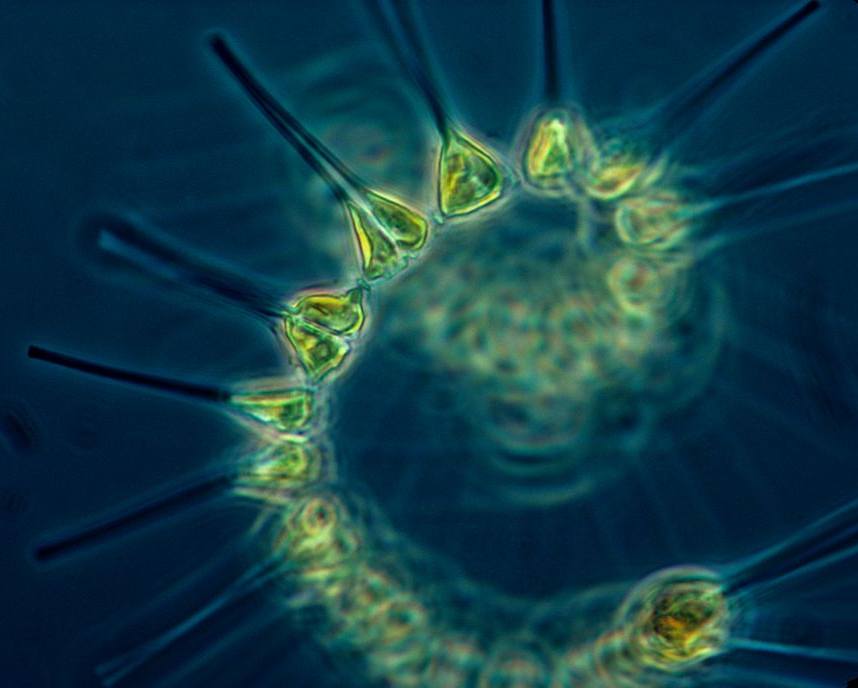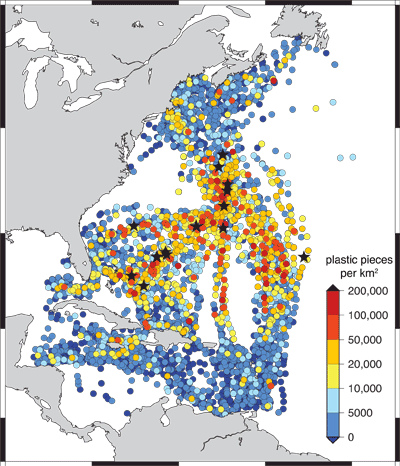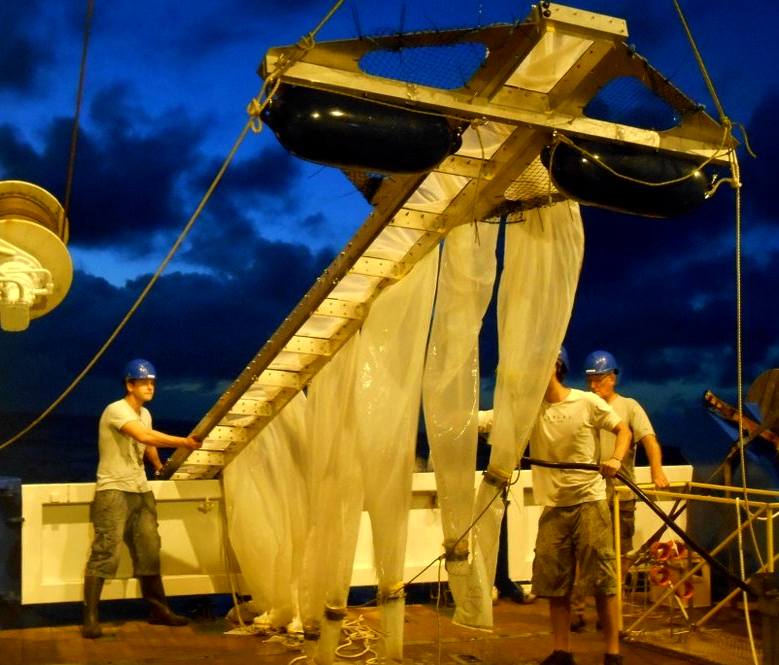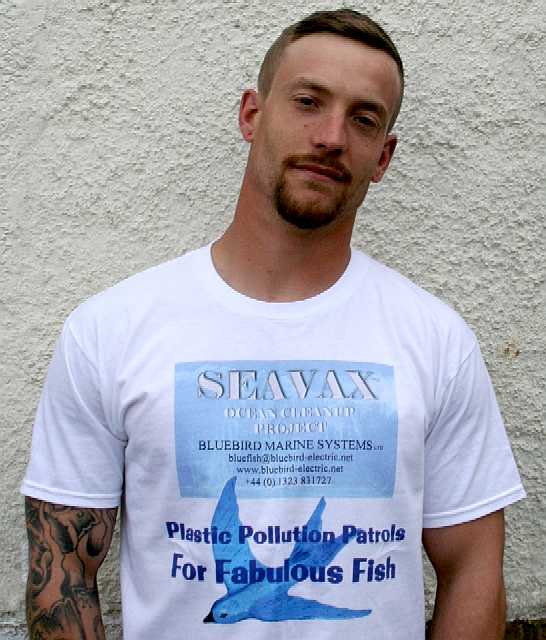|
|
PLANKTON
|
|||
|
Plankton (singular
plankter) are a diverse group of organisms that live in the water column and cannot
swim against a current. They provide a crucial source of food to many large aquatic organisms, such as
fish and
whales.
Phytoplankton are photosynthesizing microscopic organisms that inhabit the upper sunlit layer of almost all oceans and bodies of fresh water. They are agents for "primary production," the creation of organic compounds from carbon dioxide dissolved in the water, a process that sustains the aquatic food web. Phytoplankton obtain energy through the process of photosynthesis and must therefore live in the well-lit surface layer (termed the euphotic zone) of an ocean, sea, lake, or other body of water. Phytoplankton account for half of all photosynthetic activity on Earth. Their cumulative energy fixation in carbon compounds (primary production) is the basis for the vast majority of oceanic and also many freshwater food webs (chemosynthesis is a notable exception).
PLASTIC
SNACK - The effect of plastic microbeads — found in toothpaste and exfoliants — on microscopic marine life is unknown. But thanks to filmmaker
Verity
White, we can clearly see that zooplankton are ingesting the microbeads along with their normal diet of phytoplankton.
The effects of anthropogenic
warming on the global population of phytoplankton is an area of active research. Changes in the vertical stratification of the water column, the rate of temperature-dependent biological reactions, and the atmospheric supply of nutrients are expected to have important effects on future phytoplankton productivity. Additionally, changes in the mortality of phytoplankton due to rates of zooplankton grazing may be significant. As a side note, one of the more remarkable food chains in the ocean – remarkable because of the small number of links – is that of phytoplankton-feeding krill (a crustacean similar to a tiny shrimp) feeding baleen
whales.
AQUACULTURE
The majority of cultured plankton is marine, and seawater of a specific gravity of 1.010 to 1.026 may be used as a culture medium. This water must be sterilized, usually by either high temperatures in an autoclave or by exposure to ultraviolet radiation, to prevent biological contamination of the culture. Various fertilizers are added to the culture medium to facilitate the growth of plankton. A culture must be aerated or agitated in some way to keep plankton suspended, as well as to provide dissolved carbon dioxide for photosynthesis. In addition to constant aeration, most cultures are manually mixed or stirred on a regular basis. Light must be provided for the growth of phytoplankton. The colour temperature of illumination should be approximately 6,500 K, but values from 4,000 K to upwards of 20,000 K have been used successfully. The duration of light exposure should be approximately 16 hours daily; this is the most efficient artificial day length.
Distribution of plastic marine debris collected in 6136 surface plankton net tows from 1986-2008 in the western North Atlantic Ocean and Caribbean Sea. Symbols indicate the location of net tows; color indicates the measured plastic concentration in pieces per square kilometer. Black stars indicate tows with measured concentration greater than 200,000 pieces per square kilometer. Symbols are layered from low to high concentration. Figure courtesy of the Journal Science.
PLASTIC IN NORTH PACIFIC PLANKTON
Plastic in the North Pacific outnumbers zooplankton, causing concern for scientists. Plastic in the Pacific Ocean is an enormous problem – and not just for marine life. There is now six times more plastic debris in part of the North Pacific Ocean than zooplankton the populous animal plankton that forms the base of the aquatic food chain.
DEPTH OF PLASTIC POLLUTION IN OCEANS REVEALED Thursday 26 February 2015
Wind and waves can mix buoyant ocean plastics throughout the water column, but most of their mass remains at the sea surface, according to research led by The University of Western Australia.
PhD candidate Julia Reisser and her international team published the study in the journal Biogeosciences, reporting the first ever high - resolution vertical profiles of plastic pollution in the so - called “ocean garbage patches”.
Most of the submerged plastics were very small – less than 1 mm across. Previous studies noticed that tiny plastics were missing from the oceans. Ms Reisser is quoted as saying: “We have shown that at least a fraction of this missing plastic is still adrift at sea, but at depths greater than the surface layer that is usually sampled by scientists.”
When the wind was stronger than 10 knots, more than half of the 0.5-1mm particles were underwater. But even when there was no wind, about 20 per cent of these little plastics were still below the surface.
By using a new measuring device called a Multi-level Trawl, the researchers were able to measure plastic concentrations in ten layers simultaneously, down to a depth of 5 meters.
While taking measurements in the North Atlantic Garbage Patch, the team demonstrated that the mass concentration of millimeter-sized plastics drops exponentially from the sea surface to deeper waters.
The pioneering survey was conducted aboard the SV Sea Dragon, owned by Pangaea Exploration. It was sponsored by The University of Western Australia and the Ocean Cleanup Foundation.
Founder of the Ocean Cleanup Foundation and co-author of the study, Boyan Slat is quoted as saying: "The results of the study are good news to those developing technologies to extract plastic from oceanic garbage patches. Almost all plastic was on or very close to the surface, meaning it’s within reachable distances for a cleanup operation.”
ABSTRACT
- RESEARCH ARTICLE
"Millimetre-sized plastics are numerically abundant and widespread across
the world's ocean surface. These buoyant macroscopic particles can be mixed within
the upper water column by turbulent transport. Models indicate that the largest
decrease in their concentration occurs within the first few metres of water, where
Our results show that plastic concentrations drop exponentially with water depth, and decay rates decrease with increasing Beaufort number. Furthermore, smaller pieces presented lower rise velocities and were more susceptible to vertical transport. This resulted in higher depth decays of plastic mass concentration (milligrams m−3) than numerical concentration (pieces m−3). Further multi-level sampling of plastics will improve our ability to predict at-sea plastic load, size distribution, drifting pattern, and impact on marine species and habitats."
AUTHORS
1.
School of Civil, Environmental and Mining Engineering and UWA Oceans Institute,
University of Western Australia, Perth, Australia 2.
The Ocean Cleanup Foundation, Delft, the Netherlands 3.
Roger Williams University, Bristol, USA 4.
Pangaea Exploration, Miami, USA 5.
Instituto de Oceanografia, Universidade Federal do Rio Grande, Rio Grande,
Brazil 6.
Centre for Microscopy, Characterisation and Analysis, University of Western
Australia, Perth, Australia
Ms Reisser received an International Postgraduate Research Scholarship and a UWA
Completion Scholarship.
Julia Reisser
- UWA Oceans Institute - jureisser@gmail.com
PLASTIC OCEANS FOUNDATION
The Plastic Oceans Foundation is a registered United Kingdom Charity (Number 1139843). We are dedicated to protecting and improving the environment. Through a wide range of activities the Foundation will educate, provide a resource base for study and research, campaign for improvements in legislation and policy, raise funds for the development of solutions and develop a worldwide integrated social media network aimed at achieving the mission.
ACIDIFICATION - ADRIATIC - ARCTIC - ATLANTIC - BALTIC - BAY BENGAL - BERING - CARIBBEAN - CORAL - EAST CHINA ENGLISH CH - GOC - GUANABARA - GULF GUINEA - GULF MEXICO - INDIAN - IRC - MEDITERRANEAN - NORTH SEA - PACIFIC - PERSIAN GULF - SEA JAPAN STH
CHINA - PLASTIC
- PLANKTON - PLASTIC
OCEANS - SEA
LEVEL RISE - UNCLOS
- UNEP
WOC
- WWF
AMAZON - BURIGANGA - CITARUM - CONGO - CUYAHOGA - GANGES - IRTYSH - JORDAN - LENA - MANTANZA-RIACHUELO MARILAO
- MEKONG - MISSISSIPPI - NIGER - NILE - PARANA - PASIG - SARNO - THAMES
- YANGTZE - YAMUNA - YELLOW
CNET news for the first time plankton filmed eating plastic Theterramarproject big problem for the food chain tiny plankton snacking on plastic Plastic
Boards 5 Gyres - Understanding Plastic Marine Pollution Wind Driven Surface Currents: Gyres SIO 210: Introduction to Physical Oceanography - Global circulation SIO 210: Introduction to Physical Oceanography - Wind-forced circulation notes SIO 210: Introduction to Physical Oceanography - Lecture 6 Physical Geography - Surface and Subsurface Ocean Currents North Pacific Gyre Oscillation — Georgia Institute of Technology Education National Geographic ocean gyre National Geographic 2014 July ocean-plastic-debris-trash-pacific-garbage-patch Plastic Soup News Blogspot 2014_July Un package me.whats wrong with plastic Neuro research project 2013 death-by-plastic Indiegogo projects sailing the Atlantic ocean to study plastic pollution http://ecowatch.com/2014/04/07/22-facts-plastic-pollution-10-things-can-do-about-it/ Biogeosciences Net report on ocean plastic 2015 http://www.cnet.com/news/for-the-first-time-plankton-filmed-eating-plastic/ http://theterramarproject.org/thedailycatch/big-problem-for-the-food-chain-tiny-plankton-snacking-on-plastic/ http://www.biogeosciences.net/12/1249/2015/bg-12-1249-2015.html http://www.traveldailynews.asia/news/article/52369/plasticity-2013-hong-kong-serves http://ecowatch.com/2014/04/07/22-facts-plastic-pollution-10-things-can-do-about-it/ http://www.lastnightsgarbage.com/?cat=56 https://www.indiegogo.com/projects/sailing-the-atlantic-ocean-to-study-plastic-pollution http://unpackageme.com/whats-wrong-with-plastic/ http://neuroresearchproject.com/2013/02/21/death-by-plastic/ http://www.worldwildlife.org/threats/pollution http://plasticsoupnews.blogspot.co.uk/2014_07_01_archive.html http://en.wikipedia.org/wiki/Marine_debris http://www.plasticoceans.net/the-foundation/ http://www.greatrecovery.org.uk/plastic-its-a-lovehate-thing/ http://www.greatrecovery.org.uk/ http://seaplexscience.com/ http://abundantseas.org/ http://www.gyrecleanup.org/cleanup-plan/ http://education.nationalgeographic.co.uk/education/encyclopedia/ocean-gyre/?ar_a=1
SUSTAINABLE FOOD SUPPLIES - We expect to be able to safely fish the oceans for food, but for how much longer? With something like 8 million tons of plastic in three oceans, we are getting to the point where we cannot stop fish becoming dangerously toxic. A project to clean the oceans of waste is looking to put a fleet of robot ships to patrol the coastlines and gyres and suck up plastic particles. This project like all other research projects needs funding if it is to see the light of day. Where seafood is an essential resource for mankind, could we ask everyone who is able to support the SeaVax Cleaner Oceans project to help our team by contributing whatever you can.
|
||||
|
This
website is Copyright © 2016 Bluebird Marine Systems Limited.
The names Bluebird™, Bluefish™,
RiverVax™,
SeaNet™,
SeaVax™
and the blue bird in flight
|
||||






